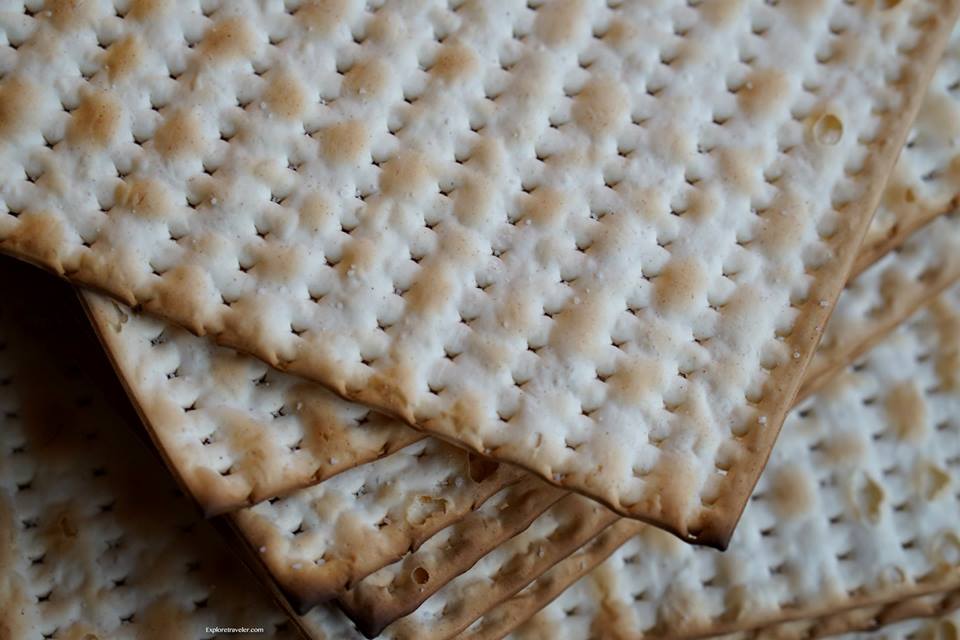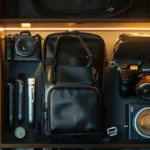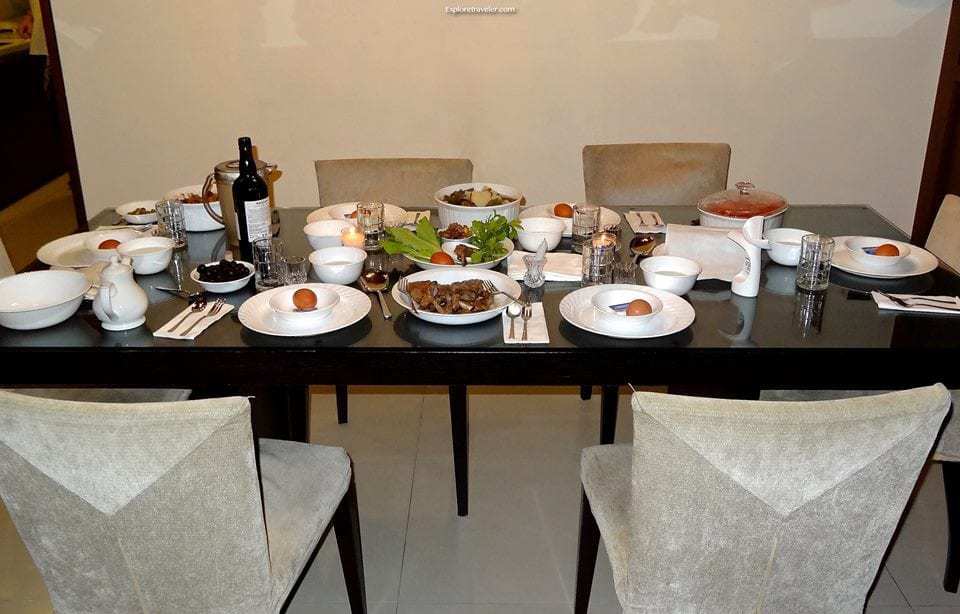 Preparing The Home For Passover
Preparing The Home For Passover
Passover or Pessach begins with the family Seder. The table is set with the finest linens and china. A special Passover plate is placed in the middle. Families will gather, big and small, to remember and to celebrate the night that the Lord passed over their homes. The blood of the lamb delivered them from death.
The houses will have been cleaned from top to bottom. Every cushion is moved to get every crumb. Windows and floors shine, carpets are squeaky clean, and the passover dishes have been washed up for the occasion. Sales on cleaning products skyrocket during this time. And if you need help, it is best to find your cleaning help months ahead. I have often wondered if this has anything to do with the idea of spring housecleaning. This is the most intense time of the year for cleaning. There is no margin for error.
There is to be no hametz left in the house for these next 7 days. Nothing that is fermented or raised. No alcohol or breads. No cakes or other specialities from the bakery, in fact, most bakeries close for those 7 days. There is no one to buy their goods. There is to be no leaven in the house. Ashkenazi, or Eastern Jews, also avoid kitniyot, a variety of food that includes legumes. Sephardic Jews, or Latin Jews, often use legumes as a major dish. Falafel is a favorite side dish in Sephardic Seders.
One important tradition is for the father to check the house for hametz with the youngest child. A few crumbs will have been left in a special place to be found and cleaned up upon discovery. All ages are actively involved in this special day of remembrance.
As the day of the family seder nears, there is much cooking. Special dishes are made that no one has made since last year. On a special plate will be the unleavened bread. This is a time to remember. It is one of the most serious holidays of the year.
The Seder Plate
In the center of the table will be the Seder plate. During the seder, we don’t just tell the story of the Exodus from Egypt, we live , smell, feel, and taste our liberation from slavery. The plate will have Karpas which represents the beginning years the Israelites were in Egypt. This is often represented with parsley. The second item will be Charoset which symbolizes the mortar that the Israelite slaves used to construct buildings for Pharaoh. The third thing is Maror or bitter herb. This is often horseradish and symbolizes the bitterness of slavery. The fourth item is the Z’roa or a Lamb Shank bone. This symbolizes the lamb that was sacrificed. The fifth item is Beizah or egg. This symbolizes the Hagigah sacrifice which was offered up on feast days when the temple stood. They are carefully arranged on the plate. The hazeret (if used) is at the six o’clock position. This is a second bitter herb and is not used by all. It is followed by karpas in the seven o’clock position, beitzah at the 11 o’clock, z’roa is at the one o’clock, and charoset at the five o’clock position. Following is the most popular way of making the Charoset.
Charoset Recipe from My Jewish Learning
1 tablespoon sugar or honey, or to taste
2 – 3 Tablespoons sweet red wine
2 medium-sized tart apples
1/2 cup (50 g) walnuts (or almonds), chopped
1/2 – 1 teaspoon cinnamon
Directions
Peel, core, and finely chop or grate the apples. Mix with the rest of the ingredients.
NOTE: On the seder table there should also be three pieces of matzah covered by a cloth and a small dipping container of salt water to dip the karpas.
During the coming week much matzo will be served as pizza, sandwiches, or as the noodles in a noodle dish. New ideas are always welcome in the kitchen. But on the Passover Seder you will find a few old friends that are served each year. One such favorite is the lamb that will be served roasted with vegetables. Many traditional salads will also grace the table. Almost every Jewish family the world over, will serve Matzah Ball Soup. The standard recipe follows. This is taken from the My Jewish Learning Website.
Ingredients for Matzah Ball soup
6 quarts of water
1 whole chicken + extra package of wings (optional)
2-3 large carrots, chopped
3 ribs of celery, chopped
1 onion, cut in half
1 medium turnip or 2 small turnips, chopped
2 parsnips, chopped
1 bunch of dill
1 bunch of flat leaf parsley
1/2 Tbsp whole peppercorns
few sprigs of thyme
salt and pepper to taste
1/2 tsp turmeric for color (optional)
Matzah Balls…either bought prepared or made fresh
Place chicken and vegetables in a 16 or 20 quart pot and cover with 6 quarts of water.
Make a bouquet garni with the fresh dill, parsley, peppercorns and thyme. Add bouquet garni to pot.
Bring pot to boil and let simmer for 1 hour. Skim the foamy stuff off the top several times while soup is cooking.
Remove chicken and veggies from pot. Allow soup to simmer additional hour with the cover on.
Shred chicken while still warm. Save about half to put into the soup, use the rest for chicken salad or sandwiches.
Allow soup to cool, and place in fridge. Skim any remaining fat off the top.
Reheat to serve. Add chicken, matzah balls and desired vegetables.
HOW TO MAKE THE MATZAH BALLS
1 cup Matzah Meal
4 large eggs
1 teaspoon Kosher salt
4 tablespoons oil or 4 tablespoons melted schmaltz (fat)
2 teaspoons Kosher baking powder
Follow these instructions carefully.
Measure and mix dry ingredients into a bowl.
Individually break the eggs into a clear glass, discarding any with blood spots, and then pour into a second bowl.
Add oil or schmaltz (and water or broth for firm matzo balls) to the eggs and stir gently with a fork until the yolks are broken and the oil just mixed.
Pour egg mixture into the dry mixture and gently mix with the fork.
DO NOT OVER MIX. Form into balls and drop into soup.
Matzo: The Star Of The Week
Matzo is the star of the week. It is like a flat cracker with little taste. Matzo or Matzah represents the Hebrews quick exodus from Egypt and their lack of time to make a proper bread. The Seder meal was eaten with their sandals on and staff in their hand. They were ready to leave the moment that God directed them to do so.
As you go from house to house this week you will see a lot of creative uses of the matzo. When it comes to using the matzo, the wheels of the mind do turn. Many Jews make a form of the Yemeni Fatut. Basically, it is Matzo broken and added to butter in a pan. It is fried until it becomes brown. Then the eggs are added with a little Kosher salt and stirred slightly to resemble scrambled eggs. When the eggs are done, your Fatut is ready. It is excellent for breakfast.
This is a time to be creative in your cooking, while working within the restrictions of the guidelines for the feast. Following is a favorite in most homes, as not many sweets grace the table during this week.
Chocolate Covered Toffee Matzo (Matzah)
Prep Time: 10 mins
Total Time: 55 mins
5 Servings
ABOUT THIS RECIPE
“Very tasty treat. In fact it is almost impossible to resist”
INGREDIENTS
1/2 lb matzos
1/2 cup butter
1 cup brown sugar
8 ounces chocolate chips
DIRECTIONS
Line a cookie sheet with foil and lay matzo on pan.
Melt brown sugar with butter in saucepan; boil until mixture coats a spoon.
Brush matzo with brown sugar mixture.
Bake in 350 degree oven for 3-4 minutes (watch closely-it burns easily!!!) until it starts to bubble.
Cover with chocolate chips and put back in the oven until the chips start to melt.
Spread the chocolate to cover the matzo.
Freeze until hard, then break into pieces.
Option- sprinkle chopped nuts on top
Retelling The Passover Story
One of the main activities is the retelling of the Passover account from the Tanakh or Bible. This account is written in the 12th chapter of Exodus. It begins with the youngest child asking why this festival is kept and remembered.
Exodus 12:26 ” And it will come to pass if your children say to you, What is this service to you?” Then the story is told of how God smote the Egyptians, but passed over all the Hebrew homes that had the blood of the lamb on the door post. For this reason this night is called 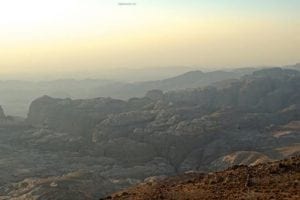
Path To The Promised Land
During this week many families take the time to share about Moses and how he led them to the promised land. It all began when the Hebrew people were led out of Egypt, the Red Sea was parted and they walked through on dry land. It then took 40 years for Moses to prepare them to enter the land that God had promised to their fathers.
Crossing The Red Sea
The very first miracle as they were leaving Egypt was that of the crossing of the Red Sea. As Moses raised his arms, the Hebrew children walked through on dry ground. As Moses began to tire, others came and helped him hold his arms, till every last one of the Hebrew people had crossed over on dry land. The waters had been parted and the people literally walked through the Red Sea. As you can see in our modern day picture of the beautiful Red Sea, this was no small miracle. After the last person crossed over and Moses entered the Sea, Pharaoh had a change of heart. As the chariots entered the Sea after the Hebrew Children, God released the Sea and it returned to normal. The horses and chariots drowned in the Sea. The Hebrew people were free at last!
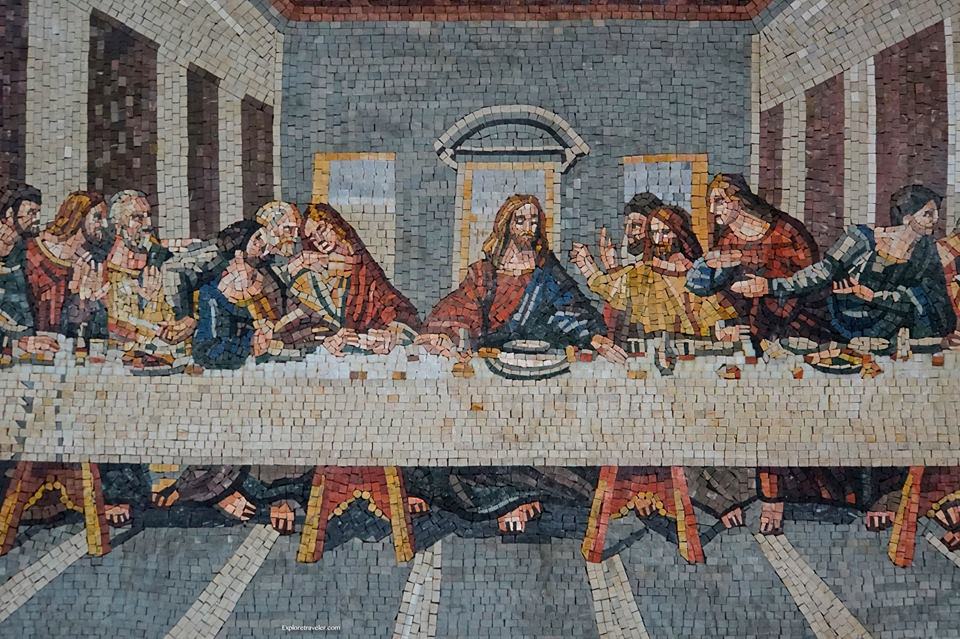
The Messianic Seder
Messianic Jews in the Holy Land and the world over follow all the above customs and guidelines for Passover. But they also realize that Yeshua(Jesus) is their Passover Lamb. They recognize that it was the sacrifice of Yeshua HaMashiach (Jesus the Christ) , as the Lamb of God, that took away the sin of the world. (John 1:29,36) This is the real meaning of Passover!
Jews remember that Passover is about the redemption of Israel and the future redemption of all of mankind. For this reason, it is a Messianic Holiday, as the Messiah is the redeemer of all humanity. Like the original Passover in Egypt, where the wrath of God passed over the homes that were under the blood of the lamb, so it is today. The sacrifice of Yeshua haMashiach, (Jesus the Christ), delivers all those covered by His blood from the bondage of sin.
Messianic Jews remember the last supper in which Yeshua (Jesus) ate the Passover with His disciples in the upper room. (Matthew 26:17-30) In verses 26-29 is the first remembrance of the Lord’s Supper. This is a major part of the celebration of the Passover for Messianic Jews. The above mosaic shows the last supper according to the account in Matthew. Particularly, Messianic Jews center their celebration on verses 26-29:
“26 And as they were eating, Jesus took bread, and blessed it, and brake it, and gave it to the disciples, and said, Take, eat; this is my body.
27 And he took the cup, and gave thanks, and gave it to them, saying, Drink ye all of it;
28 For this is my blood of the new testament, which is shed for many for the remission of sins.
29 But I say unto you, I will not drink henceforth of this fruit of the vine, until that day when I drink it new with you in my Father’s kingdom.”
The Empty Seat
At the close of every seder, Elijah is always invited into the home. As the seder concludes, the Grace After Meals is said and a cup of wine is pour for Elijah. The door is opened and he is invited in. Several prayers are said from the Psalms at this time. God is asked at this time to pour His wrath upon those who oppress His people. Tradition says that at this very time is when Elijah comes. Passover is a guarded night and when the door is open, it expresses the faith of the people in the protection of God. The door is opened and Elijah is invited into the Seder. Elijah at this time testifies that all the males present have been circumcised. Elijah’s cup of wine is poured also at this time.
Passover In The Land
Please remember that unless you are joining family or friends to eat the Seder, that there are very few public seders. Chabad house generally has a seder for travelers. There are also a few other Synagogues which have a Seder for those traveling. A contact for a public Seder in Jerusalem is the Chabad House listed below. If you will be in a different location, they can help you find one in the area of the country where you will be. Chabad has more than 40 Seders throughout Israel to meet the needs of travelers.
Ma’alot Nakhalat Shiv’a 5
Jerusalem, Israel
Mailing Address:
Menakhem 4
Jerusalem, 94720 Israel
A limited number of restaurants are open, but can be few and far between. If you are planning to have the Seder in your hotel, you will want to make sure that everything you need is bought and prepared ahead of time. Most businesses and restaurants will be closed during Passover. Some businesses and restaurants will remain closed for the complete 8 day feast. The majority will open up Sunday at the normal time.
ExploreTraveler
